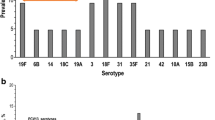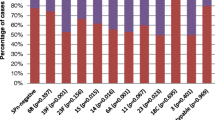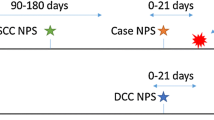Abstract
The purpose of this study was to examine the association between bacterial colonization/infection and respiratory outcomes in children younger than 3 years old who were hospitalized for their first wheezing episode. This was an observational study. The primary outcome was hospitalization time and the secondary outcomes included relapses within 2 months and time to recurrent wheezing (i.e. three physician confirmed wheezing episodes) within 12 months. Bacterial antibody assays for Streptococcus pneumoniae, Haemophilus influenzae, Moraxella catarrhalis, Mycoplasma pneumoniae and Chlamydia pneumoniae were studied as well as nasopharyngeal bacterial culture for the three former and urine pneumococcal antigen. Nasopharyngeal bacterial culture was positive in 31/52 (60%) children, serologic evidence of bacterial infection was found in 17/96 (18%) children, urine pneumococcal antigen was positive in 24/101 (24%), and any bacterial detection method was positive in 53/106 (50%) children. The children with positive nasopharyngeal bacterial culture had longer duration of hospitalization (hazard ratio 2.4) and more often relapsed within two months than those with negative culture (odds ratio 7.3). In this study, half of the first time wheezing children had bacterial colonization or symptomatic or asymptomatic bacterial infection. The bacterial colonization (i.e. positive nasopharyngeal bacterial culture) was associated with longer duration of hospitalization and higher risk of recurrent wheezing.


Similar content being viewed by others
References
Heymann PW, Carper HT, Murphy DD, Platts-Mills TA, Patrie J, McLaughlin AP et al (2004) Viral infections in relation to age, atopy, and season of admission among children hospitalized for wheezing. J Allergy Clin Immunol 114(2):239–247
Allander T, Jartti T, Gupta S, Niesters H, Lehtinen P, Österback R et al (2007) Human bocavirus and acute wheezing in children. Clin Infect Dis 44(7):904–910
Bruder D, Srikiatkhachorn A, Enelow RI (2006) Cellular immunity and lung injury in respiratory virus infection. Viral Immunol 19(2):147–155
Esposito S, Blasi F, Arosio C, Fioravanti L, Fagetti L, Droghetti R et al (2000) Importance of acute Mycoplasma pneumoniae and Chlamydia pneumoniae infections in children with wheezing. Eur Respir J 16(6):1142–1146
Normann E, Gnarpe J, Wettergren B, Janson C, Wickman M, Nordvall L (2006) Association between Chlamydia pneumoniae antibodies and wheezing in young children and the influence of sex. Thorax 61(12):1054–1058
Nagayama Y, Tsubaki T, Nakayama S, Sawada K, Taguchi K, Toba T et al (2007) Bacterial colonization in respiratory secretions from acute and recurrent wheezing infants and children. Pediatr Allergy Immunol 18(2):110–117
Lehtinen P, Jartti T, Virkki R, Vuorinen T, Leinonen M, Peltola V et al (2006) Bacterial coinfections in children with viral wheezing. Eur J Clin Microbiol Infect Dis 25(7):463–469
Yu D, Wei L, Zhengxiu L, Jian L, Lijia W, Wei L, et al. Impact of bacterial colonization on the severity and airway inflammation of children with virus induced wheezing. Clin Microbiol Infect 2009. [Epub ahead of print]
Kotaniemi-Syrjänen A, Vainionpää R, Reijonen TM, Waris M, Korhonen K, Korppi M (2003) Rhinovirus-induced wheezing in infancy—the first sign of childhood asthma? J Allergy Clin Immunol 111(1):66–71
Lemanske RF, Jackson DJ, Gangnon RE, Evans MD, Li Z, Shult PA et al (2005) Rhinovirus illnesses during infancy predict subsequent childhood wheezing. J Allergy Clin Immunol 116(3):571–577
Lehtinen P, Ruohola A, Vuorinen T, Vanto T, Ruuskanen O, Jartti T (2007) Prednisolone reduces recurrent wheezing after a first wheezing episode associated with rhinovirus infection or eczema. J Allergy Clin Immunol 119(3):570–575
Kusel MM, de Klerk NH, Kebadze T, Vohma V, Holt PG, Johnston SL et al (2007) Early-life respiratory viral infections, atopic sensitization, and risk of subsequent development of persistent asthma. J Allergy Clin Immunol 119(5):1105–1110
Bisgaard H, Hermansen MN, Buchvald F, Loland L, Halkjaer LB, Bønnelykke K et al (2007) Childhood asthma after bacterial colonization of the airway in neonates. N Engl J Med 357(15):1487–1495
Talbot TR, Hartert TV, Mitchel E, Halasa NB, Arbogast PG, Poehling KA et al (2005) Asthma as a risk factor for invasive pneumococcal disease. N Engl J Med 352(20):2082–2090
Juhn YJ, Kita H, Yawn BP, Boyce TG, Yoo KH, McGree ME et al (2008) Increased risk of serious pneumococcal disease in patients with asthma. J Allergy Clin Immunol 122(4):719–723
Jartti T, Lehtinen P, Vanto T, Hartiala J, Vuorinen T, Mäkelä MJ et al (2006) The efficacy of prednisolone in early wheezing induced by rhinovirus or respiratory syncytial virus. Pediatr Infect Dis J 25(6):482–488
Jartti T, Lehtinen P, Vanto T, Vuorinen T, Hartiala J, Hiekkanen H et al (2007) Efficacy of prednisolone in children hospitalized for recurrent wheezing. Pediatr Allergy Immunol 18(4):326–334
Jartti T, Lehtinen P, Vuorinen T, Österback R, van den Hoogen B, Osterhaus AD et al (2004) Respiratory picornaviruses and respiratory syncytial virus as causative agents of acute expiratory wheezing in children. Emerg Infect Dis 10(6):1095–1101
Mertsola J, Ziegler T, Ruuskanen O, Vanto T, Koivikko A, Halonen P (1991) Recurrent wheezy bronchitis and viral respiratory infections. Arch Dis Child 66(1):124–129
Korppi M, Leinonen M, Koskela M, Mäkelä PH, Saikku P, Launiala K (1991) Bacterial infection in under school age children with expiratory difficulty. Pediatr Pulmonol 10(4):254–259
García-Rodríguez JA, Fresnadillo Martínez MJ (2002) Dynamics of nasopharyngeal colonization by potential respiratory pathogens. J Antimicrob Chemother 50(Suppl S2):59–73
Ong BH, Gao Q, Phoon MC, Chow VT, Tan WC, Van Bever HP (2007) Identification of human metapneumovirus and Chlamydophila pneumoniae in children with asthma and wheeze in Singapore. Singapore Med J 48(4):291–293
Watson K, Carville K, Bowman J, Jacoby P, Riley TV, Leach AJ et al (2006) Upper respiratory tract bacterial carriage in Aboriginal and non-Aboriginal children in a semi-arid area of Western Australia. Pediatr Infect Dis J 25(9):782–790
Harrison LM, Morris JA, Telford DR, Brown SM, Jones K (1999) The nasopharyngeal bacterial flora in infancy: effects of age, gender, season, viral upper respiratory tract infection and sleeping position. FEMS Immunol Med Microbiol 25(1–2):19–28
Cardozo DM, Nascimento-Carvalho CM, Andrade AL, Silvany-Neto AM, Daltro CH, Brandão MA et al (2008) Prevalence and risk factors for nasopharyngeal carriage of Streptococcus pneumoniae among adolescents. J Med Microbiol 57(Pt 2):185–189
Ghaffar F, Friedland IR, McCracken GH Jr (1999) Dynamics of nasopharyngeal colonization by Streptococcus pneumoniae. Pediatr Infect Dis J 18(7):638–646
Borer A, Meirson H, Peled N, Porat N, Dagan R, Fraser D et al (2001) Antibiotic-resistant pneumococci carried by young children do not appear to disseminate to adult members of a closed community. Clin Infect Dis 33(4):436–444
St Sauver J, Marrs CF, Foxman B, Somsel P, Madera R, Gilsdorf JR (2000) Risk factors for otitis media and carriage of multiple strains of Haemophilus influenzae and Streptococcus pneumoniae. Emerg Infect Dis 6(6):622–630
Faden H, Duffy L, Williams A, Krystofik DA, Wolf J (1995) Epidemiology of nasopharyngeal colonization with nontypeable Haemophilus influenzae in the first 2 years of life. J Infect Dis 172(1):132–135
Hartert TV (2008) Are persons with asthma at increased risk of pneumococcal infections, and can we prevent them? J Allergy Clin Immunol 122(4):724–725
Johnston SL (2007) Innate immunity in the pathogenesis of virus-induced asthma exacerbations. Proc Am Thorac Soc 4(3):267–270
Holt PG, Upham JW, Sly PD (2005) Contemporaneous maturation of immunologic and respiratory functions during early childhood: implications for development of asthma prevention strategies. J Allergy Clin Immunol 116(1):16–24
Peltola VT, McCullers JA (2004) Respiratory viruses predisposing to bacterial infections: role of neuramidase. Pediatr Infect Dis J 23(1 Suppl):S87–S97
Kusel MM, de Klerk N, Holt PG, Sly PD (2008) Antibiotic use in the first year of life and risk of atopic disease in early childhood. Clin Exp Allergy 38(12):1921–1928
Jartti T, Vanto T, Heikkinen T, Ruuskanen O (2002) Systemic glucocorticoids in childhood expiratory wheezing: relation between age and viral etiology with efficacy. Pediatr Infect Dis J 21:873–878
Marguet C, Jouen-Boedes F, Dean TP, Warner JO (1999) Bronchoalveolar cell profiles in children with asthma infantile wheeze, chronic cough, or cystic fibrosis. Am J Respir Crit Care Med 159(5 Pt 1):1533–1540
Fayon M, Just J, Thien HV, Pascual L, Sandouk G, Grimfeld A (1999) Bacterial flora of the lower respiratory tract in children with bronchial asthma. Acta Paediatr 88(11):1216–1222
Krawiec ME, Westcott JY, Chu HW, Balzar S, Trudeau JB, Schwartz LB et al (2001) Persistent wheezing in very young children is associated with lower respiratory inflammation. Am J Respir Crit Care Med 163(6):1338–1343
Le Bourgeois M, Goncalves M, Le Clainche L, Benoist MR, Fournet JC, Scheinmann P et al (2002) Bronchoalveolar cells in children <3 years old with severe recurrent wheezing. Chest 122(3):791–797
National Heart, Lung and Blood Institute (2007) Expert panel report 3 (EPR3): Guidelines for the diagnosis and management of asthma. http://www.nhlbi.nih.gov/guidelines/asthma/asthgdln.htm. Accessed 05 October 2010
Illi S, von Mutius E, Lau S, Niggemann B, Grüber C, Wahn U et al (2006) Perennial allergen sensitisation early in life and chronic asthma in children: a birth cohort study. Lancet 368(9537):763–770
Jartti T, Lehtinen P, Vuorinen T, Ruuskanen O (2009) Bronchiolitis: age and previous wheezing episodes are linked to viral etiology and atopic characteristics. Pediatr Infect Dis J 28(4):311–317
Conflict of interest
None.
Addition to proofs
A recent study showed that acute wheezy episodes in young children of a high risk cohort were associated with bacterial infections similar to, but independent of the association with, virus infections. (Bisgaard H, Hermansen MN, Bønnelykke K, Stokholm J, Baty F, Skytt NL, et al (2010) Association of bacteria and viruses with wheezy episodes in young children: prospective birth cohort study. BMJ 4;341:c4978).
Author information
Authors and Affiliations
Corresponding author
Additional information
This work was supported by the Academy of Finland (Grants 114034 and 132595), the Finnish Cultural Foundation, the Turku University Foundation, the Foundation for Pediatric Research, the Foundation for Out-patient Research, and the Paulo Foundation.
Rights and permissions
About this article
Cite this article
Jartti, T., Kuneinen, S., Lehtinen, P. et al. Nasopharyngeal bacterial colonization during the first wheezing episode is associated with longer duration of hospitalization and higher risk of relapse in young children. Eur J Clin Microbiol Infect Dis 30, 233–241 (2011). https://doi.org/10.1007/s10096-010-1075-z
Received:
Accepted:
Published:
Issue Date:
DOI: https://doi.org/10.1007/s10096-010-1075-z




